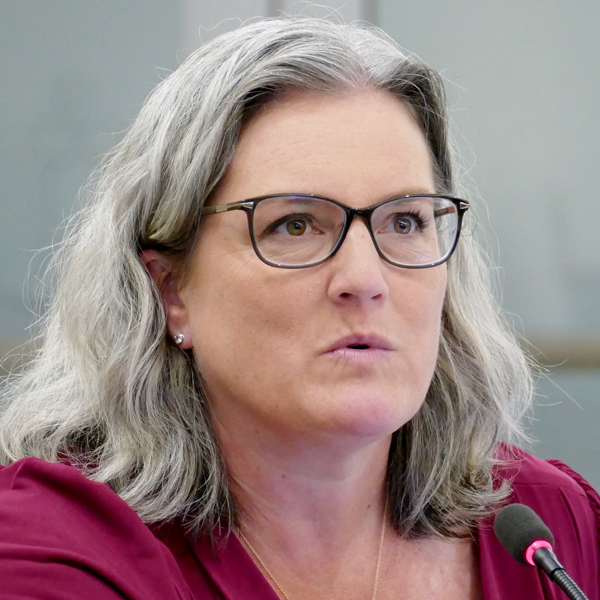Markets and Reliability Committee
MRC Discusses MSOC and CPQR Changes
The PJM Markets and Reliability Committee added a discussion of the market seller offer cap (MSOC) and capacity performance quantifiable risk (CPQR) to its Jan. 25 agenda at the behest of stakeholders concerned that the current constructs may not fully reflect the risk of penalties paid during emergency conditions.
Jeff Whitehead, of GT Power Group, said the current MSOC was built on the assumption that emergency performance assessment intervals (PAIs) would be few and far between. However, the 277 PAIs occurring on Dec. 23 and 24 during Winter Storm Elliott has challenged that notion.
 Jeff Whitehead, GT Power Group | © RTO Insider LLC
Jeff Whitehead, GT Power Group | © RTO Insider LLCWith the 2025/26 Base Residual Auction (BRA) approaching and generation owners facing as much as $2 billion in performance penalties stemming from Elliott, Whitehead said it’s important that sellers are able to understand how the storm will impact the offers they can submit. (See PJM Gas Generator Failures Eyed in Elliott Storm Review.)
PJM Vice President of Market Services Stu Bresler said there are two meetings of the Resource Adequacy Senior Task Force (RASTF) — including Jan. 31 — and one Market Implementation Committee meeting before the next MRC meeting. He said the issue can be added to those agendas with the goal of having a proposal to present to the MRC at its February meeting. Given the current timeline for the June BRA, he said actionable market changes would likely require an alternative auction schedule.
Gregory Carmean, of the Organization of PJM States Inc. (OPSI), said that any changes to the auction schedule would be disruptive to states that run their own markets to procure energy.
Noting that the funding for bonus payments is derived from the penalties paid by underperforming generators, Carmean questioned why the capacity performance mechanism results in “exorbitant prices” for ratepayers and doesn’t net out to be cost neutral. Given that energy-only resources aren’t subject to penalties, he also asked why they are eligible to receive bonus payments.
PJM’s Adam Keech said the bonus payments are distributed to any overperforming resources to create an incentive to provide power when it is needed most, regardless of whether it comes from capacity or energy resources.
Jason Barker, of Constellation Energy, said many small or new market participants may not have developed the tools needed to fully model the performance risk to their facilities, creating a roadblock to offering as a capacity resource. A pro forma system where sellers can provide data and receive expectations of how their unit may perform could be a short-term step as broader market designs are considered.
Independent Market Monitor Joseph Bowring said it’s reasonable to raise the narrow issue of the interaction between Elliott and PJM’s market mechanisms.
“It is straightforward to include the PAI data from Elliott in the simulation calculations used to calculate CPQR,” he said. “But is important not to be hyperbolic about the impact of the Elliott PAI. It should come as no surprise to anyone that the market experienced PAI. But this is the first significant PAI event in the history of CP. This can be handled within the existing rules.”
Greg Poulos, of the Consumer Advocates of the PJM States (CAPS), noted that the conversation was occurring little more than a month out from the storm and data collection is still underway. Rather than rushing the MSOC conversation, he pushed for a more cautious approach.
“Overall, we would prefer to have a comprehensive market discussion and go at it that way rather than have a piecemeal and plug a hole, with a couple bandages over it,” he said.
Stakeholders Endorse Expansion of Hybrid Resource Rules
The rollout for the second phase of market rules for hybrid resources was approved by the MRC Wednesday, expanding the definition of hybrid to any combination of fuel types. The first phase created a set of market rules for the most predominant form of mixed-fuel facilities, solar and storage combinations, with the classification and metering language effective Oct. 1, 2022, and the energy market model scheduled to go live this June. The proposal requires FERC approval. (See PJM MRC Moves Forward on Storage, Hybrids.)
The new hybrid definition would allow for more resource pairings, such as hydrogen and solar or gas and solar, to benefit from the market provisions in the first phase, regardless of whether they are paired with storage. The market model for inverter-based storage hybrids is based on the phase one structure.
The proposal approved last week creates a new market model for inverter-based, generation-only hybrids, such as wind and solar modeled on the existing system for wind resources. The EcoMax and uplift parameters currently in place for wind resources are also being applied for hybrids.
Other MRC Business:
- Stakeholders endorsed revisions to the charter for the emerging technologies forum to shift toward an emphasis on stakeholder discussion and debate, rather than a focus on education. The changes also include references to new Manual 34 language regarding forums, including added clarification that discussions in forums cannot be used to bypass the existing stakeholder issue resolution process.
- The MRC approved a proposal to change how PJM models power flows in its day-ahead model to look at all 24 hours for the reference date. With changes in load patterns, particularly from behind-the-meter solar and data center development, PJM’s Amanda Martin said additional accuracy in aligning day-ahead and real-time flows is necessary. (See “First Read on Changes to Day-ahead Zonal Load Bus Distribution Factors,” PJM MIC Briefs: Nov. 2, 2022.)
Members Committee
Stakeholders Endorse Pathway for Issues to be Brought Directly to MC
The Members Committee endorsed a motion from Adrien Ford, of Old Dominion Electric Cooperative, to allow members to bring some issues best addressed by the MC directly before the body through a problem statement and issue charge, rather than having to be first considered by lower committees.
 Adrien Ford, Old Dominion Electric Cooperative | © RTO Insider LLC
Adrien Ford, Old Dominion Electric Cooperative | © RTO Insider LLCThe manual revisions were endorsed by the committee by acclamation with eight objections and five abstentions, all in the end-use customer sector.
Poulos said it’s best to have a problem statement and issue charge whenever possible to allow stakeholders to have a clear understanding of why a topic is being discussed. However, he worried that requiring those could lead to administrative discussion down the road that gets in the way of substantive work.
He asked Ford if she would be amicable to an amendment to her language to change the requirement that a problem statement and issue charge be approved by the MC be changed to recommend, but not mandate, that process. Such a change would also allow for issues to be voted on by the committee the same day they’re broached.
Ford said she could not accept the amendment, as the language was drafted by a group of stakeholders over a long period of time.
PJM Considering New Non-performance Charge Billing Schedule
PJM CFO Lisa Drauschak presented a series of adjustments the RTO is considering to its non-performance charge billing schedule to extend the amount of time market participants have to make payments when performance assessment intervals (PAIs) fall near the end of the delivery year.
Currently, billing is split between the remaining months in the delivery year after the charges have been determined for a generator. For PAIs in the summer this leaves as much as nine months for payments to be made, but for Winter Storm Elliot there will only be three months to make payments once the penalties have been determined.
PJM’s proposal would amend the tariff to allow payments to be split over an additional six months if less than six months remain in the delivery year once charges have been determined.
A second option being considered is to allow members who have been assessed penalties to elect to either pay them across the greater of the remainder of the delivery year, or three months, with no interest, or to have a six-month floor with interest added at the FERC prevailing rate. The alternative is based on stakeholder feedback received during the Jan. 24 meeting of the Risk Management Committee regarding the possibility of incorporating interest into the payment methods.
PJM General Counsel Chris O’Hara said that under the current language, if there were to be a PAI in the last two months of a delivery year, the collection period would already extend into the next delivery year, so the proposal is also an attempt to fix a broken provision.



